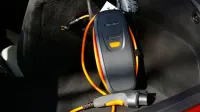GM replacing almost all Chevrolet Volt power cords

Fox said that the new cords are not related to the overheating problems we heard about last year. Instead, some Volt customers returned their units for replacement last fall, and GM engineers saw the update as something that could be done to “enhance the customer experience.” In the cases where overheating was reported, Fox said, GM found most of them were caused by a worn or damaged AC wall outlet. Fox would not disclose how much this replacement program would cost GM, but extra 120V cords cost between $360 and up.
Fox added that, since many Volt owners need to contact their Chevrolet dealers to begin scheduling appointments to have additional crash structure enhancements added around the vehicle’s battery packs, they can be given the new cords when they come in for the repair. The additional steel is designed to protect against severe side-impacts. Technicians are also expected to add a new sensor to monitor battery coolant levels. The changes are in response to a National Highway Traffic Safety Administration investigation into unlikely vehicle fires. GM will reportedly continue to sell Volt models without the new structure and sensor, saying neither poses a safety issue.




